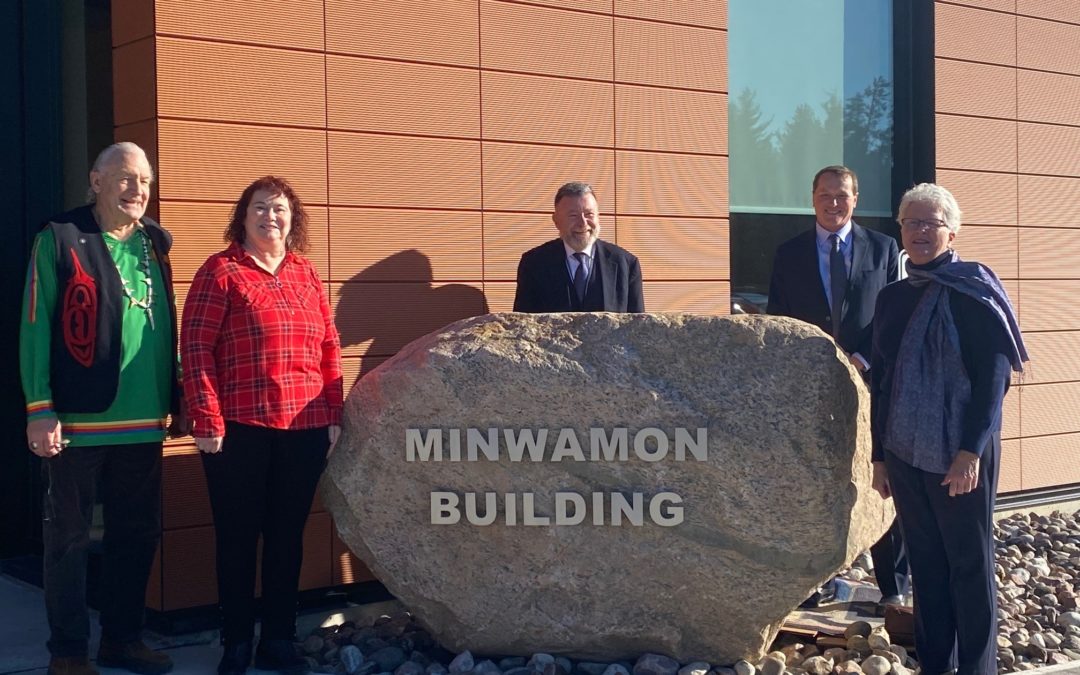
Algonquins of Ontario Honour AECL and CNL with Name for New Site Entrance Building at Chalk River Campus
Canada’s national nuclear laboratory welcomes Algonquins of Ontario representatives to Chalk River Laboratories to celebrate opening of new ‘Minwamon Building’
Atomic Energy of Canada Limited (AECL) and Canadian Nuclear Laboratories (CNL) are pleased to announce that the Algonquins of Ontario (AOO) have honoured the organizations by bestowing a name upon their new site entrance building at the Chalk River Laboratories. Now known as the Minwamon Building, which means ‘clear path’ in the Algonquin language, the facility was officially inaugurated during a ceremony held earlier today at the Chalk River campus.
CNL’s President and CEO, Joe McBrearty, and AECL’s President and CEO, Fred Dermarkar, were joined by Algonquin Negotiation Representatives Lynn Clouthier, Ottawa Algonquin Community, and Connie Mielke, Algonquins of Greater Golden Lake, to reveal the new name as part of the celebration, which included a smudge ceremony by Elder Dan Ross to commemorate the unveiling. Opened earlier this year, the Minwamon Building has transformed the site entry experience for employees and the public.
“I want to thank the Algonquins of Ontario, Fred Dermarkar and our other guests for joining us today to celebrate the Minwamon Building,” commented McBrearty. “I also want to thank the AOO for honouring us with a name that captures the spirit of not only this building, which serves as the entry point to the campus and our research, but also our commitment to sustainable operations. We truly appreciate this generous gift, and we will continue to grow and nurture our relationship with the Algonquin People as part of the journey on our clear path.”
“We want to thank CNL and AECL for this naming opportunity. This building is a testament to our understanding that everything and everyone is connected. The path we are on together must be a clear and good path. Our actions today on this land on the banks of our sacred Kichi-Sìbì river will echo through the next seven generations,” commented Connie Mielke.
“Today’s event brings us together in a meaningful way as AECL, CNL and the AOO continue to advance our relationship,” said Fred Dermarkar, President and CEO of AECL. “We are honoured to be inaugurating this building in partnership with the AOO, and to be gifted the Minwamon name as a way to recognize our commitment to working together towards healing and reconciliation.”
AECL and CNL are committed to meaningful engagement with local First Nations and Métis communities to identify mutually beneficial partnerships and opportunities for collaboration. In particular, we recognize that Indigenous knowledge and involvement complements and improves the operation of our sites, as well as environmental and employment matters. The gifting of the new name for the Minwamon Building is another positive step in pursuit of these goals and is part of a broader effort between AECL, CNL and the AOO to formalize a long-term relationship.
The Minwamon Building is one of a series of new buildings that are being constructed at the Chalk River campus. Among the many environmentally friendly features of the facility, its main structural material is a new generation of mass timber products sourced from within Canada, a renewable resource that reduces CNL’s carbon footprint. It was also constructed using strategies that include sustainable site development, water and energy efficiency, materials selection, and indoor environmental quality. Designed by HDR Architects and LEA Consulting Engineers, the building was recently named a recipient of the Ontario Wood Design Innovation Award, which recognizes new projects that push the limits of wood design in structures.
New buildings at the Chalk River Laboratories are part of a 10-year capital program, funded through a $1.2-billion investment from AECL, that is designed to transform the site through the revitalization of essential site infrastructure and a significant investment in new, world-class science facilities. For more information on CNL, including the revitalization of the Chalk River Laboratories campus, please visit www.cnl.ca.
About CNL
Canadian Nuclear Laboratories is a world leader in nuclear science and technology offering unique capabilities and solutions across a wide range of industries. Actively involved with industry-driven research and development in nuclear, transportation, clean technology, energy, defence, security and life sciences, we provide solutions to keep these sectors competitive internationally.
With ongoing investments in new facilities and a focused mandate, Canadian Nuclear Laboratories is well positioned for the future. A new performance standard reinforced with a strong safety culture underscores every activity.
For more information on the complete range of Canadian Nuclear Laboratories services, please visit www.cnl.ca or contact communications@cnl.ca.
About AECL
AECL is a federal Crown corporation with a mandate to drive nuclear opportunities for Canada. Working with Canadian Nuclear Laboratories, AECL enables nuclear science and technology and manages the Government of Canada’s radioactive waste responsibilities.
About the AOO
The Algonquins of Ontario (AOO) are on a journey of survival, rebuilding and self-sufficiency – a journey of reconciliation. This journey began nearly 250 years ago when the first Algonquin petition was submitted to the Crown in 1772. Algonquins have lived in present-day Ontario for thousands of years before Europeans arrived. Today, the AOO are comprised of ten Algonquin communities.
Based on a protocol signed in 2004, the ten Algonquin Communities are working together to provide a unified approach to negotiate a modern-day treaty. The unceded AOO Settlement Area, includes an area of more than nine million acres within the watersheds of the Kichi-Sìbì and the Mattawa River in Ontario, unceded territory that covers most of eastern Ontario, including the Chalk River Laboratories site.
For more information about the AOO, please visit www.tanakiwin.com.
| Algonquins of Ontario contact:
Daniel Charbonneau Executive Director, AOO |
Atomic Energy of Canada Limited contact:
Maude-Émilie Pagé Director, Communications and Government Reporting 343-303-5345 |
| Canadian Nuclear Laboratories contact:
Patrick Quinn Director, Corporate Communications CNL, 1-866-886-2325 |
